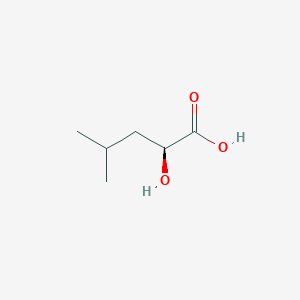| General Information of MET (ID: META00313) |
| Name |
Hydroxyisocaproic acid
|
| Synonyms |
Click to Show/Hide Synonyms of This Metabolite
(+)-2-Hydroxyisocaproate; (+)-2-Hydroxyisocaproic acid; (+)-a-Hydroxyisocaproate; (+)-a-Hydroxyisocaproic acid; (+)-alpha-Hydroxyisocaproic acid; (2S)-2-Hydroxy-4-methylpentanoate; (2S)-2-Hydroxy-4-methylpentanoic acid; (S)-2-Hydroxy-4-methyl-pentanoate; (S)-2-Hydroxy-4-methyl-pentanoic acid; (S)-2-Hydroxyisocaproate; (S)-2-Hydroxyisocaproic acid; (S)-Leucate; (S)-Leucic acid; 2-HYDROXY-4-methyl-pentanoIC ACID; 2-HYDROXY-4-methyl-pentanoate; Hydroxy-isocaproate; Hydroxyisocaproate; L-2-Hydroxy-4-methylvalerate; L-2-Hydroxy-4-methylvaleric acid; L-2-Hydroxyisocaproate; L-2-Hydroxyisocaproic acid; L-Leucate; L-Leucic acid; L-a-Hydroxyisocaproate; L-a-Hydroxyisocaproic acid; L-alpha-Hydroxyisocaproic acid; S-2-Hydroxy-4-methylpentanoate; S-2-Hydroxy-4-methylpentanoic acid
|
| Source |
Endogenous;Yeast Metabolite;Fatty acyls;Food;Microbial
|
| Structure Type |
Fatty acids and conjugates (Click to Show/Hide the Complete Structure Type Hierarchy)
Lipids and lipid-like molecules
Fatty Acyls
Fatty acids and conjugates
|
| PubChem CID |
|
| HMDB ID |
|
| Formula |
C6H12O3
|
| Structure |
<iframe style="width: 300px; height: 300px;" frameborder="0" src="https://embed.molview.org/v1/?mode=balls&cid=83697"></iframe>
|
 |
|
3D MOL
|
2D MOL
|
|
Click to Show/Hide the Molecular/Functional Data (External Links/Property/Function) of This Metabolite
|
| ChEBI ID |
|
| FooDB ID |
|
| ChemSpider ID |
|
| METLIN ID |
|
| Physicochemical Properties |
Molecular Weight |
132.16 |
Topological Polar Surface Area |
57.5 |
| XlogP |
0.9 |
Complexity |
98.5 |
| Heavy Atom Count |
9 |
Rotatable Bond Count |
3 |
| Hydrogen Bond Donor Count |
2 |
Hydrogen Bond Acceptor Count |
3 |
| Function |
Hydroxyisocaproic acid is an end product of leucine metabolism in human tissues such as muscle and connective tissue. It belongs to 2-hydroxycarboxylic acid group of amino acid metabolites. Hydroxyisocaproic acid functions as an nti-catabolite and is widely used in the body building community. Chronic alpha-hydroxyisocaproic acid treatment of rats has been shown to improve muscle recovery after immobilization-induced atrophy. Additionally, a 4-week hydroxyisocaproic acid supplementation of 1.5 g a day was shown to lead to increases in muscle mass during an intensive training period among soccer athletes. Hydroxyisocaproic acid has also shown some potential as a topical antibiotic. Elevated levels of 2-hydroxyisocaproic acid have been found in the urine of patients with dihydrolipoyl dehydrogenase (E3) deficiency. Hydroxyisocaproic acid is also elevated in maple syrup urine disease, a genetic disorder, and has been shown to accelerate lipid peroxidation. It may also be an indicator of oxidative stress. Hydroxyisocaproic acid has been found to be a metabolite of Lactobacillus and fungal species (http://jultika.oulu.fi/files/isbn9789526211046.pdf).
|
|
Regulatory Network
|
|
|
|
|
|
|
|
|
 click to show the details of this protein
click to show the details of this protein
 click to show the details of experiment for validating this pair
click to show the details of experiment for validating this pair

